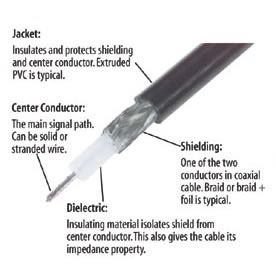Coax is one of the most venerable cabling standards having been developed for the US military over 50 years ago. Unlike some standards that were popular for a while and eventually became legacy, coaxial cabling is still very relevant and used in a lot of common applications. It is a robust and reliable cable type with no sign of going away any time soon.
Types of Coax Cabling
As you can imagine, over the years that coax has been around, many variations have been designed for specific applications. We will talk about the Radio Guide (RG) styles and the low-loss styles that were made popular by Times Microwave's LMR® standard. Though there are many other coax options like mini coax, twinaxial and tri-axial, the applications for those have dwindled in recent years.
RG-style Coaxial Cable
The original Radio Guide standard called for a number followed by codes to determine specific aspects of the cable (such as jacket type, center conductor material, etc.). However, today many of the standards have become "soft" meaning that RG58B/U, for instance, may have very different characteristics from manufacturer to manufacturer.

Most RG numbers refer to cables made with specific diameters (as thicker diameters typically have lower attenuation over long lengths), shielding, jacket type, and dielectric type. The dielectric is important as it can control the "characteristic impedance" of the cable. In general, cables with a characteristic impedance of 50 Ohms are used in data and wireless network applications, and cables with a characteristic impedance of 75 Ohms are used in higher bandwidth audio/video applications.
The bottom line about RG-style coax cable: if you need to get a specific type for your application, you should include the characteristics of the cable with your request. The actual standard may have some variations that would make the off-the-shelf product unsuitable for some circumstances.
Low-loss Coaxial Cable
Low-loss cable is almost exclusively used in wireless applications. It is ideal for any antenna-to-radio setup, and is often used extensively in wireless system installations. Low loss cable is often referred to by its series number, such as 200-Series cable, which is usually a rough approximation of the diameter of the cable. The higher the number (ie, 400, 800, etc), the thicker and heavier the cable, and the less attenuation over the length. Because of this, higher series numbers are typically used in cases where the antenna is permanently installed at some distance from the radio. Lower series numbers are used in cases where the antenna is closer, especially in portable setups where the weight of the cable is important.
Coax Connectors
There are a large variety of coaxial connectors, usually designated by a letter or combination of letters. Most coaxial connectors are round or hex shaped, and can come in screw-on, push-on, or twist-lock designs. Be extra careful if you need a connector that is called "reverse polarized" or preceded with the letters "RP". These connectors are similar to the regular polarity versions except that the gender of the connector is reversed, making it unable to mate unless it is with another RP style connector. For a complete list of coaxial connectors with large images, try this coaxial connector chart.

